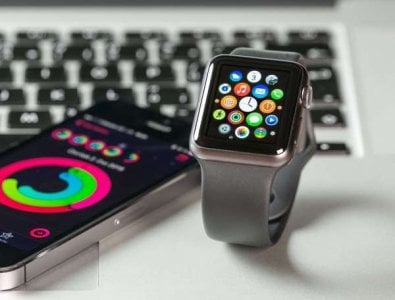Is your smartwatch harbouring potentially harmful bacteria? Find out now!
By
VanessaC
- Replies 4
As technology evolves, more of us are stepping into the world of wearable devices. While smartwatches can be a great way of staying connected with family and friends or tracking our steps and exercise, researchers from Florida Atlantic University warn that they may harbour potentially harmful bacteria.
In their study published in the Journal of Advances in Infectious Diseases, the researchers looked at 20 smartwatch wristbands made from metal, leather, plastic, cloth and rubber.
They found that nearly all the bands were contaminated, with most bacteria linked to contagious staph infections, E.coli, which can cause food poisoning or pneumonia, and pseudomonas aeruginosa, which can lead to blood infections.
In terms of numbers, 85 per cent of wristbands harboured Staphylococcus bacteria, 60 per cent had E.coli bacteria, while pseudomonas bacteria was found on 30 per cent of the bands.
The researchers said: ‘Even at relatively low numbers, (they are) of public health significance.’
Moreover, wristbands made of cloth had the most bacteria, followed by those made of plastic and rubber. This is because of their 'porous and static surfaces' that tend to attract and be colonised by bacteria.
The researchers also found metal bands such as gold or silver harboured little to no bacteria.
The subjects who had the most bacteria on their watches were those who worked with animals or attended the gym due to the high levels of bacteria found in nature and traditional gyms.
To keep wristbands clean and free from most bacteria, researchers recommended using cleaning products with ethanol to disinfect, finding they had a kill rate of more than 99.99 per cent. Research has also shown that Apple cider vinegar, which is often used as a household cleaning agent, was found to be less effective in disinfecting.
More Information on How to Properly Clean and Disinfect Wearable Devices
Cleaning wearable technology should be a routine part of your daily hygiene. The process isn't complicated but requires some continued commitment to ensure that your favourite devices are as germ-free as possible.
It might also be beneficial for you to keep a schedule of how often you'll be giving your devices a thorough cleaning. For those engaged in physical activities or have a profession that exposes them to higher levels of bacteria, such as gym aficionados or animal care workers, it's recommended to clean your smartwatch daily. As for less exposed individuals, a weekly clean is a good practice to adopt.
Next, pay attention to your choice of cleaning agents. As the researchers suggested, cleaning products that contain ethanol can be highly effective disinfectants and a majority of households will already have products containing ethanol as it's a common ingredient in many commercial cleaning items.
The cleaning process is simple–apply a small dab of the cleaning product to a clean microfibre cloth and gently clean your smartwatch band. It's helpful to remember not to directly apply cleaning agents on your devices as it can lead to potential harm especially when dealing with screens.
If your device has a metal band you can use warm water and mild dish soap to clean gold or silver bands. Once you've cleaned the band, dry it properly to avoid any damage caused by moisture over time.
Accessorising with wearable technology shouldn't threaten your health. By following these simple cleaning tips, you can ensure that your smartwatch remains a great partner in your wellness journey instead of being a potential germ carrier.
You can watch this guide on how to clean your smartwatch wristbands below:

Do you wear a smartwatch? Share with us how you clean your wristbands in the comments below!
In their study published in the Journal of Advances in Infectious Diseases, the researchers looked at 20 smartwatch wristbands made from metal, leather, plastic, cloth and rubber.
They found that nearly all the bands were contaminated, with most bacteria linked to contagious staph infections, E.coli, which can cause food poisoning or pneumonia, and pseudomonas aeruginosa, which can lead to blood infections.
In terms of numbers, 85 per cent of wristbands harboured Staphylococcus bacteria, 60 per cent had E.coli bacteria, while pseudomonas bacteria was found on 30 per cent of the bands.
The researchers said: ‘Even at relatively low numbers, (they are) of public health significance.’
Moreover, wristbands made of cloth had the most bacteria, followed by those made of plastic and rubber. This is because of their 'porous and static surfaces' that tend to attract and be colonised by bacteria.
The researchers also found metal bands such as gold or silver harboured little to no bacteria.
The subjects who had the most bacteria on their watches were those who worked with animals or attended the gym due to the high levels of bacteria found in nature and traditional gyms.
To keep wristbands clean and free from most bacteria, researchers recommended using cleaning products with ethanol to disinfect, finding they had a kill rate of more than 99.99 per cent. Research has also shown that Apple cider vinegar, which is often used as a household cleaning agent, was found to be less effective in disinfecting.
More Information on How to Properly Clean and Disinfect Wearable Devices
Cleaning wearable technology should be a routine part of your daily hygiene. The process isn't complicated but requires some continued commitment to ensure that your favourite devices are as germ-free as possible.
It might also be beneficial for you to keep a schedule of how often you'll be giving your devices a thorough cleaning. For those engaged in physical activities or have a profession that exposes them to higher levels of bacteria, such as gym aficionados or animal care workers, it's recommended to clean your smartwatch daily. As for less exposed individuals, a weekly clean is a good practice to adopt.
Next, pay attention to your choice of cleaning agents. As the researchers suggested, cleaning products that contain ethanol can be highly effective disinfectants and a majority of households will already have products containing ethanol as it's a common ingredient in many commercial cleaning items.
The cleaning process is simple–apply a small dab of the cleaning product to a clean microfibre cloth and gently clean your smartwatch band. It's helpful to remember not to directly apply cleaning agents on your devices as it can lead to potential harm especially when dealing with screens.
If your device has a metal band you can use warm water and mild dish soap to clean gold or silver bands. Once you've cleaned the band, dry it properly to avoid any damage caused by moisture over time.
Accessorising with wearable technology shouldn't threaten your health. By following these simple cleaning tips, you can ensure that your smartwatch remains a great partner in your wellness journey instead of being a potential germ carrier.
You can watch this guide on how to clean your smartwatch wristbands below:
Key Takeaways
- A study from Florida Atlantic University revealed that cloth, plastic, and rubber smartwatch wristbands can harbour bacteria linked to staph infections and E.coli.
- The study analysed 20 smartwatch wristbands of various materials and found that nearly all of the bands were contaminated, with those made of cloth harbouring the most bacteria.
- The research determined that pseudomonas bacteria on 30 per cent, E.coli bacteria on 60 per cent of the bands, and Staphylococcus bacteria were detected on 85 per cent of wristbands.
- The researchers recommend using cleaning products with ethanol to properly disinfect these devices, as it was found to have a kill rate of more than 99.99 per cent.
Do you wear a smartwatch? Share with us how you clean your wristbands in the comments below!








